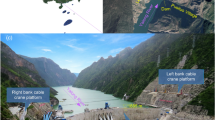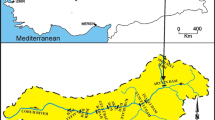Abstract
The deformation modulus of a rock mass is one of the crucial parameters used in the design of surface and underground rock engineering structures. Due to the problems in determining the deformability of jointed rock masses at the laboratory scale, various in-situ test methods have been developed. Although these methods are currently the best techniques, they are expensive and time-consuming, and present operational problems. To overcome this difficulty, in this paper, based on the basic concepts of a rock engineering systems (RES) approach, a new model for the prediction of the deformation modulus of a rock mass is presented. The newly proposed approach involves seven effective parameters (depth, rock quality designation, uniaxial compressive strength, the discontinuity density, the condition of discontinuities, the groundwater condition, and an adjustment for the orientation of discontinuities) pertinent to the deformation modulus of a rock mass, yet keeping simplicity as well. The performance of the RES model is compared with multiple regression models. The estimation abilities offered using RES and multiple regression models were presented by using field data obtained from road and railway construction sites in Korea. The results achieved indicate that the RES-based model predictor with the least mean square error and a higher coefficient of determination (R 2) performs better than the multiple regression models.
Similar content being viewed by others
References
Agüero A, Pinedo P, Simón I, Cancio D, Moraleda M, Trueba C, Pérez-Sánchez D (2008) Application of the Spanish methodological approach for biosphere assessment to a generic high-level waste disposal site. Sci Total Environ 403:34–58
Avila R, Moberg L (1999) A systematic approach to the migration of 137Cs in forest ecosystems using interaction matrices. J Environ Radioactiv 45:271–282
Bahri Najafi A, Saeedi GR, Ebrahimi Farsangi MA (2014) Risk analysis and prediction of out-of-seam dilution in longwall mining. Int J Rock Mech Min Sci 70:115–122
Barton N (2002) Some new Q value correlations to assist in site characterization and tunnel design. Int J Rock Mech Min Sci 39:185–216
Benardos A, Kaliampakos D (2004) A methodology for assessing geotechnical hazards for TBM tunnelling—illustrated by the Athens Metro, Greece. Int J Rock Mech Min Sci 41:987–999
Bieniawski Z (1973) Engineering classification of rock masses. Trans S Afr Inst Civ Eng 15:335–344
Bienniawski Z (1989) Engineering rock mass classification. Wiley, New York
Cancelli A, Crosta G (1993) Hazard and risk assessment in rockfall prone areas Risk and reliability in ground engineering. Thomas Telford, London, pp 177–190
Chun B-S, Ryu WR, Sagong M, Do J-N (2009) Indirect estimation of the rock deformation modulus based on polynomial and multiple regression analyses of the RMR system. Int J Rock Mech Min Sci 46:649–658
Condor J, Asghari K (2009) An alternative theoretical methodology for monitoring the risks of CO2 leakage from wellbores. Energy Proc 1:2599–2605
Faramarzi F, Farsangi ME, Mansouri H (2013a) An RES-based model for risk assessment and prediction of backbreak in bench blasting. Rock Mech Rock Eng 46:877–887
Faramarzi F, Mansouri H, Ebrahimi Farsangi M (2013b) A rock engineering systems based model to predict rock fragmentation by blasting. Int J Rock Mech Min Sci 60:82–94
Faramarzi F, Mansouri H, Farsangi MAE (2014) Development of rock engineering systems-based models for flyrock risk analysis and prediction of flyrock distance in surface blasting. Rock Mech Rock Eng 47:1291–1306
Fattahi H (2016) Application of improved support vector regression model for prediction of deformation modulus of a rock mass. Eng Comput 32:567–580
Gholamnejad J, Bahaaddini H, Rastegar M (2013) Prediction of the deformation modulus of rock masses using artificial neural networks and regression methods. J Min Environ 4:35–43
Gokceoglu C, Sonmez H, Kayabasi A (2003) Predicting the deformation moduli of rock masses. Int J Rock Mech Min Sci 40:701–710
Gokceoglu C, Yesilnacar E, Sonmez H, Kayabasi A (2004) A neuro-fuzzy model for modulus of deformation of jointed rock masses. Comput Geotech 31:375–383
Hoek E, Brown E (1997) Practical estimates of rock mass strength. Int J Rock Mech Min Sci 34:1165–1186
Hoek E, Diederichs M (2006) Empirical estimation of rock mass modulus. Int J Rock Mech Min Sci 43:203–215
Hudson JA (1992) Rock engineering systems: theory and practice. Horwood, Chichester
Jammalamadaka SR (2003) Introduction to linear regression analysis. Am Stat 57:67–87. doi:10.1198/tas.2003.s211
Kayabasi A, Gokceoglu C, Ercanoglu M (2003) Estimating the deformation modulus of rock masses: a comparative study. Int J Rock Mech Min Sci 40:55–63
Lagina Serafim J, Pereira J (1983) Considerations on the geomechanical classification of Beniawski. In: International symposium on engineering geology and underground construction, pp II, 33-II, 42
Lu P, Latham J (1994a) A continuous quantitative coding approach to the interaction matrix in rock engineering systems based on grey systems approaches. In: Proceedings of 7th international congress of the IAEG, Lisbon, Portugal, pp 4761–4770
Lu P, Latham JP (1994b) A continuous quantitative coding approach to the interaction matrix in rock engineering systems based on grey systems approaches. In: Proceedinsg of the 7th international congress of IAEG. Balkema, Rotterdam, pp 4761–4770
Majdi A, Beiki M (2010) Evolving neural network using a genetic algorithm for predicting the deformation modulus of rock masses. Int J Rock Mech Min Sci 47:246–253
Matthews M, Lloyd B (1998) The river test catchment surveillance project South Water Utilities Final Research Report, Department of Civil Engineering, University of Surrey, UK
Mavroulidou M, Hughes SJ, Hellawell EE (2004) A qualitative tool combining an interaction matrix and a GIS to map vulnerability to traffic induced air pollution. J Environ Manag 70:283–289
Mazzoccola D, Hudson J (1996) A comprehensive method of rock mass characterization for indicating natural slope instability. Q J Eng Geol 29:37–56
Mitri H, Edrissi R, Henning J (1995) Finite-element modeling of cable-bolted stopes in hard-rock underground mines. Trans-Soc Min Metall Explor Inc 298:1897–1902
Moradi MR, Farsangi MAE (2014) Application of the risk matrix method for geotechnical risk analysis and prediction of the advance rate in rock TBM tunneling. Rock Mech Rock Eng 47:1951–1960
Nicholson G, Bieniawski Z (1990) A nonlinear deformation modulus based on rock mass classification. Int J Min Geol Eng 8:181–202
Palmström A, Singh R (2001) The deformation modulus of rock masses—comparisons between in situ tests and indirect estimates. Tunn Undergr Sp Tech 16:115–131
Ping L, Hudson J (1993) A fuzzy evaluation approach to the stability of underground excavations. In: ISRM international symposium-EUROCK 93. International Society for Rock Mechanics
Saffari A, Ataei M, Ghanbari K (2013) Applying rock engineering systems (RES) approach to evaluate and classify the coal spontaneous combustion potential in Eastern Alborz coal mines. Int J Min Geo Eng 47:115–127
Serafim JL, Pereira JP (1983) Considerations of the geomechanics classification of Bieniawski. In: International symposium on engineering geology and underground construction, pp 1133–1144
Shin H-S, Kwon Y-C, Jung Y-S, Bae G-J, Kim Y-G (2009) Methodology for quantitative hazard assessment for tunnel collapses based on case histories in Korea. Int J Rock Mech Min Sci 46:1072–1087
Skagius K, Wiborgh M, Ström A, Morén L (1997) Performance assessment of the geosphere barrier of a deep geological repository for spent fuel: the use of interaction matrices for identification, structuring and ranking of features, events and processes. Nucl Eng Des 176:155–162
Sonmez H, Ulusay R, Gokceoglu C (2004) Indirect determination of the modulus of deformation of rock masses based on the GSI system. Int J Rock Mech Min Sci 41:849–857
Sonmez H, Gokceoglu C, Nefeslioglu H, Kayabasi A (2006) Estimation of rock modulus: for intact rocks with an artificial neural network and for rock masses with a new empirical equation. Int J Rock Mech Min Sci 43:224–235
van Dorp F, Egan M, Kessler JH, Nilsson S, Pinedo P, Smith G, Torres C (1998) Biosphere modelling for the assessment of radioactive waste repositories; the development of a common basis by the BIOMOVS II reference biospheres working group. J Environ Radioactiv 42:225–236
Velasco H, Ayub J, Belli M, Sansone U (2006) Interaction matrices as a first step toward a general model of radionuclide cycling: application to the 137 Cs behavior in a grassland ecosystem. J Radioanal Nucl Ch 268:503–509
Zhang L, Einstein H (2004) Using RQD to estimate the deformation modulus of rock masses. Int J Rock Mech Min Sci 41:337–341
Author information
Authors and Affiliations
Corresponding author
Rights and permissions
About this article
Cite this article
Fattahi, H., Moradi, A. A new approach for estimation of the rock mass deformation modulus: a rock engineering systems-based model. Bull Eng Geol Environ 77, 363–374 (2018). https://doi.org/10.1007/s10064-016-1000-5
Received:
Accepted:
Published:
Issue Date:
DOI: https://doi.org/10.1007/s10064-016-1000-5












